Causes of Mental Illness
1/63
There's no tags or description
Looks like no tags are added yet.
Name | Mastery | Learn | Test | Matching | Spaced |
|---|
No study sessions yet.
64 Terms
Learned Helplessness by Martin Seligman
Where a person (or an animal) learns to believe that they have no control over what happens to them, even when control is possible.
Learned optimism
The positive side of learned helplessness.
Being optimistic when faced with considerable stress and difficulty.
Social learning by Bandura
process of altering behaviour by observing and imitating the behaviour of others
He observed that animals do not have to directly experience certain events in their environment to learn effectively. They can learn by observing what happens to someone else in a given situation.
Principle of equifinality
Used in developmental psychopathology to indicate that we must consider many paths to a given result.
helps explain why people can develop the same psychological disorder or behaviour even though their life experiences or causes are different.
What is etiology in the context of mental illness?
The study of causation or origin, focusing on the causes, origins, or reasons behind mental disorders.
Psychosexual stage by Freud
Stage-related problems
1- Oral stage (0-1 y/o)
Focus: Mouth — sucking, eating, biting
Transition from breastfeeding to solid food
Adult traits: alcohol consumption, smoking, overeating
Anal stage (2-3 y/o)
Focus: Desire for control
Children want to seek control and independence (e.g toilet training)
Adult traits: Controlling, perfectionism, cleanliness obsession
Phallic stage (3-6 y/o)
Focus: genital area
A child has a preference for the opposite sex parent for pleasure. (Oedipus/boys, Electra/girls) complex.
Latency stage (6-12 y/o)
Focus: social and intellectual development (sexual urges)
Immaturity, inability to develop meaningful relationships.
Genital stage (12 and +)
Focus: mature and sexual interests and relationships
Socialization, lifelong relationships.
What are the five types of anxiety identified by Freud?
Reality anxiety (based on real threats),
Neurotic anxiety (from unconscious fears)
Moral anxiety (from conflicts between the ego and superego).
Unresolved conflicts and traumas from childhood.
Repressed memories (might surface when triggered)
What was the significance of Little Hans in Freud's theories?
Little Hans's fear of horses was interpreted by Freud as a displacement of his fear of his father, linked to the Oedipus complex.
How can early parental rejection affect mental health?
It may predispose individuals to later develop depression.
True or False, Unconscious anger toward the lost love object (someone you’re deeply attracted to — a parent, partner, friend) is turned inward leading to self-criticism, guilt and shame.
True
What is classical conditioning in the context of anxiety? (Pavlov)
A learned response where anxiety is triggered by stimuli associated with a previous anxiety-inducing event.
What role does operant conditioning play in anxiety? (B.F. Skinner)
Avoiding anxiety-provoking situations can reinforce the anxiety response, making avoidance more likely in the future.
What is observational learning in relation to anxiety?
Children may learn anxious responses by observing anxious behaviors in parents or caregivers.
True or False, Depression may result from a decrease in positive reinforcement or rewards from the environment.
True
Cognitive Model of Anxiety?
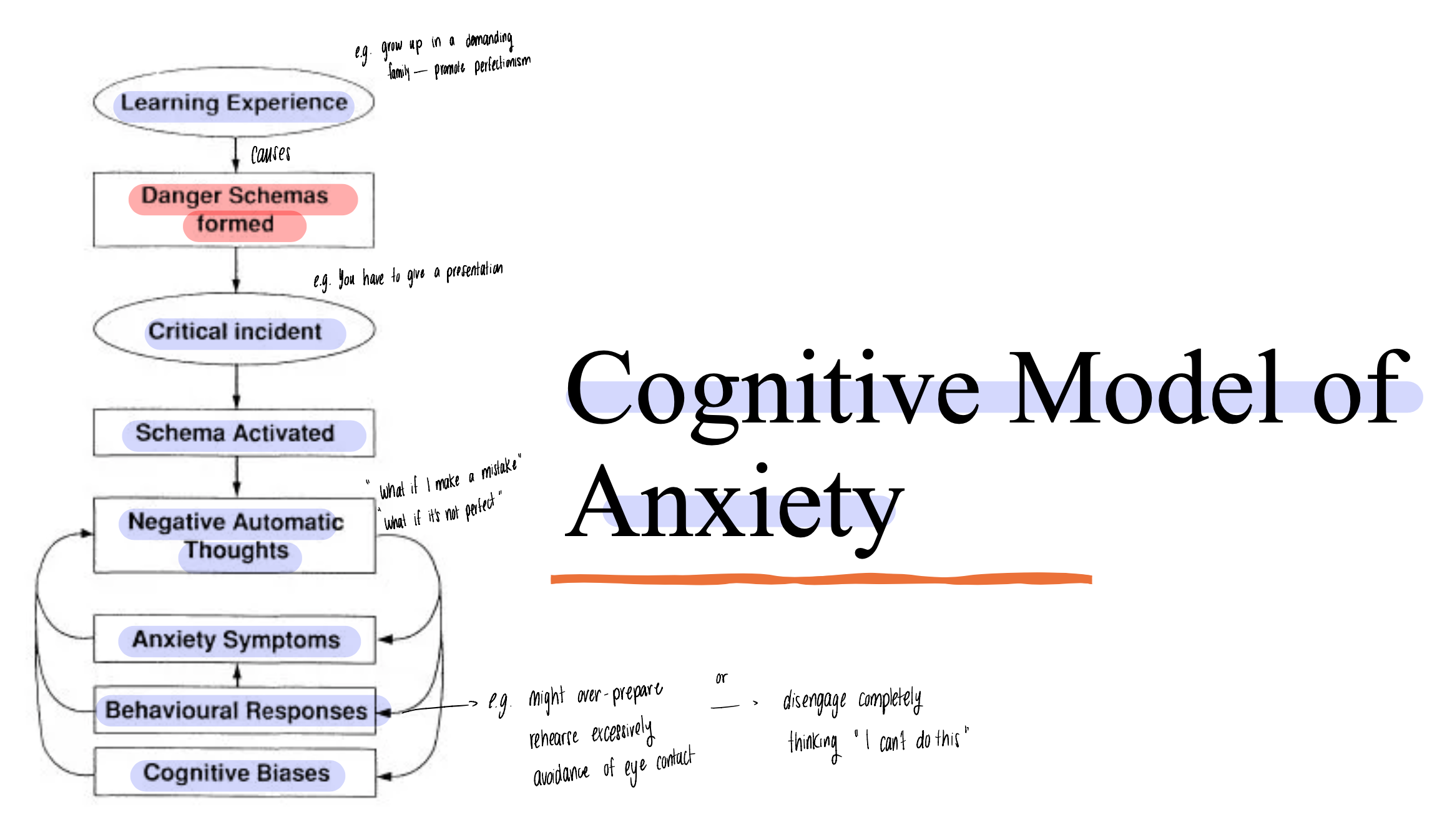
What is an anxiety schema?
Mental framework that predisposes an individual to experience heightened levels of fear and worry.
People with an anxiety schema often interpret ambiguous or neutral stimuli as threatening, overestimating the likelihood or severity of negative events.
Cognitive Model of Depression
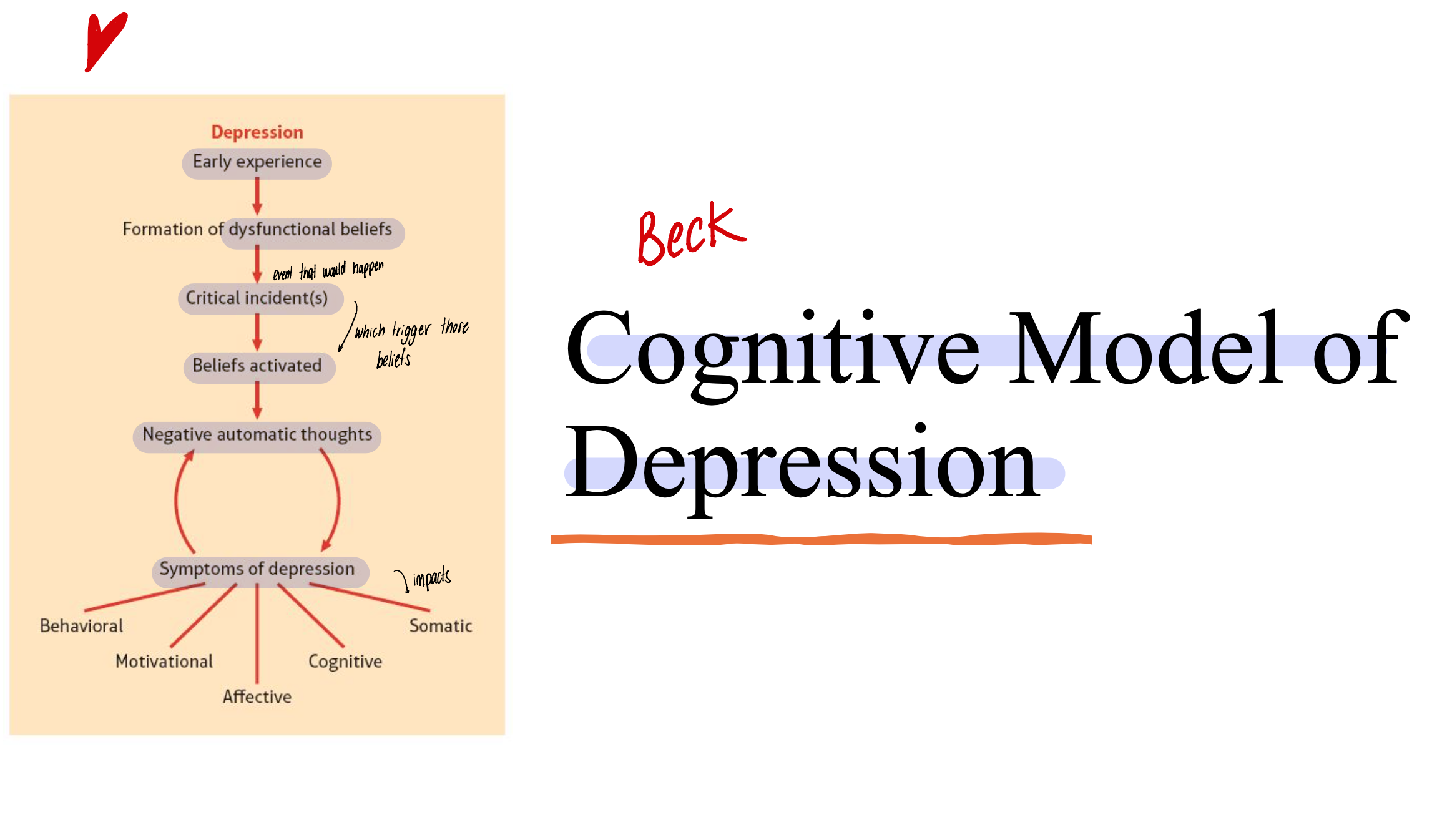
The cognitive triad of Depression
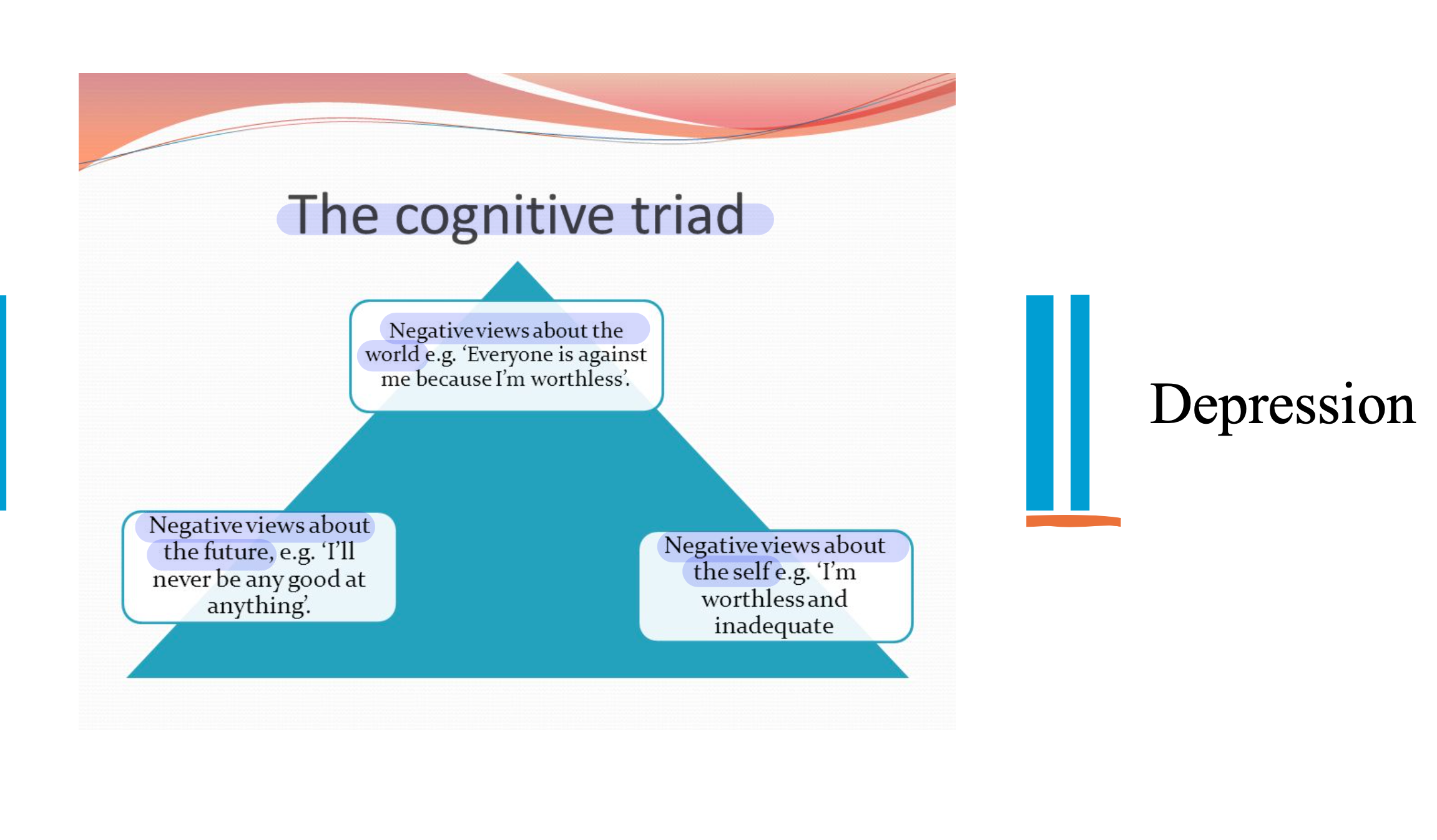
What is the biochemical theory of anxiety?
Anxiety disorders are linked to imbalances in neurotransmitters.
What are the neurotransmitters linked to anxiety?
Serotonin: known for regulating mood, sleep and appetite. Low levels are associated with an increase in anxiety + mood disorders.
Norepinephrine: “fight or flight response. known for regulating alertness and arousal. Imbalanced levels contribute to anxiety symptoms.
GABA: critical for reducing neuronal excitability. Low levels increase anxiety because GABA plays a role in calming the brain and nervous system.
What is the biochemical theory of depression?
The monoamine hypothesis of depression is the dominant biochemical model of depression.
What are the neurotransmitters linked to depression?
Serotonin: regulates mood, sleep, appetite and emotional stability
Norepinephrine: reduced activity associated with feelings of fatigue and low motivation, as it influences arousal, alertness, and energy levels.
Dopamine: involved in the reward system and motivation. Low levels can contribute to anhedonia (loss of the ability to experience pleasure)
What are the genetics linked to emotional disorders?
Genetic predisposition: emotional disorders tend to run in families (hereditary component). People with first-degree relatives who have a disorder are at higher risk of developing similar conditions.
Heritability (refers to how much of the differences we see in a trait among people): research + twin studies reveal that emotional disorders have a significant genetic component.
Gene-environment interactions: Genetic predisposition interacts with environmental factors (stress or trauma). Genetic predisposition only manifests as a disorder when triggered by environmental stressors.
What do concordance rates indicate in genetic studies of mental disorders?
They show the likelihood that both twins will have the same disorder, with higher rates in monozygotic (MZ) twins compared to dizygotic (DZ) twins.
What did Hans Selye observe about stress?
He observed that patients with various chronic illnesses (such as tuberculosis and cancer) can have common set of symptoms called now “stress”
What did Hans Selye contribute to the understanding of stress?
He noted that stress can arise from both negative and positive situations, can exceed a person's adaptational resources and can occur in more than one form.
Which types of major depressive disorder have the strongest or most common causes of depression?
Chronic pain, cancer, renal disease and lung disease
What is the diathesis-stress model? What is the meaning of this term?
It describes how mental disorders develop when a person with a pre-existing vulnerability experiences a major stressor. A disorder develops only if vulnerability and stress occur together.
Diathesis = vulnerability, a predisposition
Stress = environmental trigger (e.g. trauma, loss of a loved one, relationship problems)
What are protective factors in the diathesis-stress model?
Elements that decrease the likelihood of negative outcomes, such as a supportive family environment, successful exposure to a stress event and resilience = the ability to successfully adapt to very difficult circumstances.
What is the role of the parasympathetic nervous system?
Known as the “rest and digest”, it conserves energy by slowing the heart rate, reducing blood pressure, and promoting relaxation.
What is the function of the sympathetic nervous system?
Known as the “fight or flight,” It prepares the body for stressful situations by increasing heart rate and blood pressure.
What is the role of the three divisions of the brain?
Forebrain: responsible for complex cognitive activities, sensory processing, emotional regulation and voluntary motor activities.
Midbrain: role for vision, hearing, motor control, sleep/wake cycles and temperature regulation
Hindbrain: life-supporting functions such as respiration, heart rate and balance.
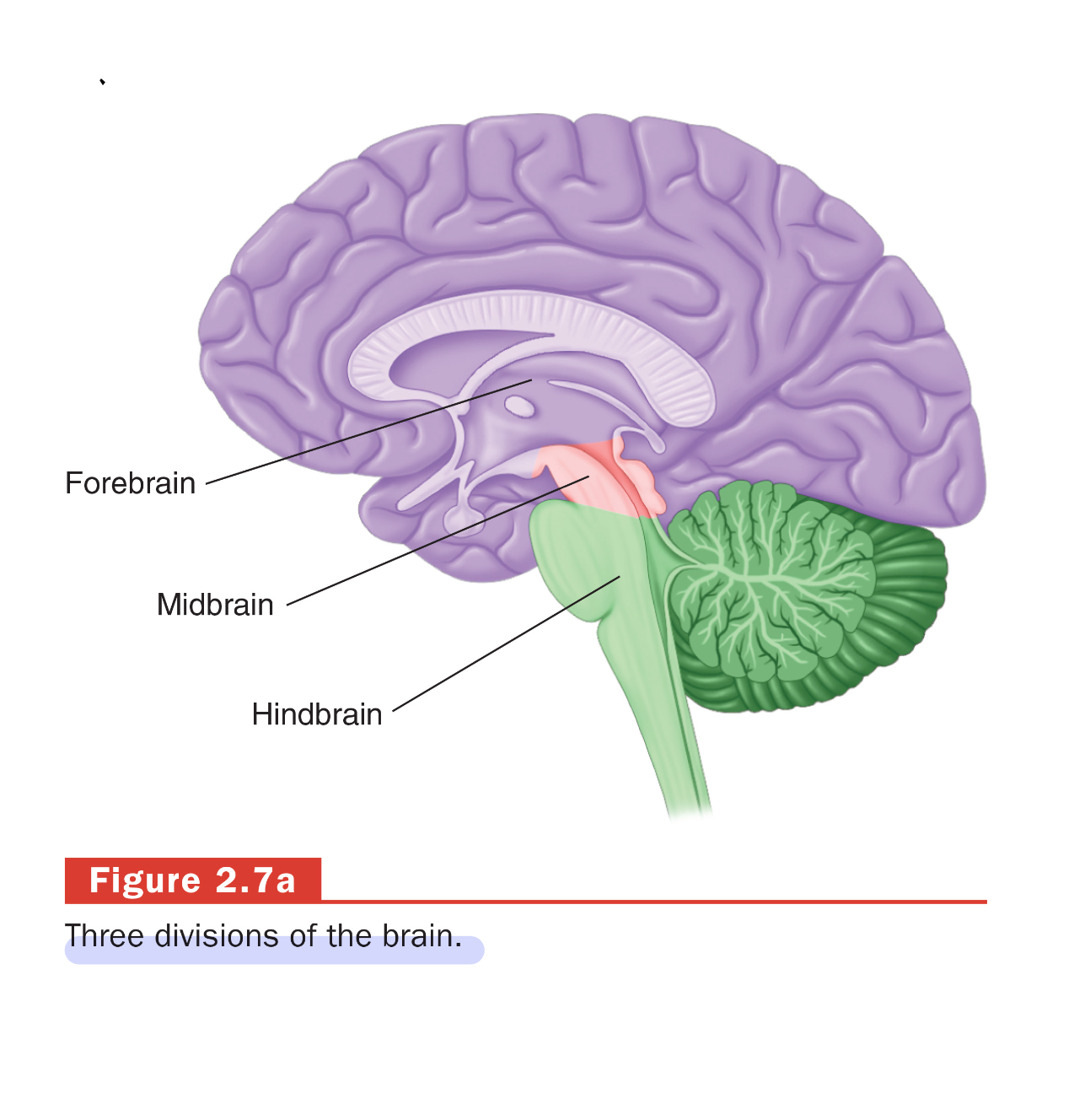
Major structure of the brain
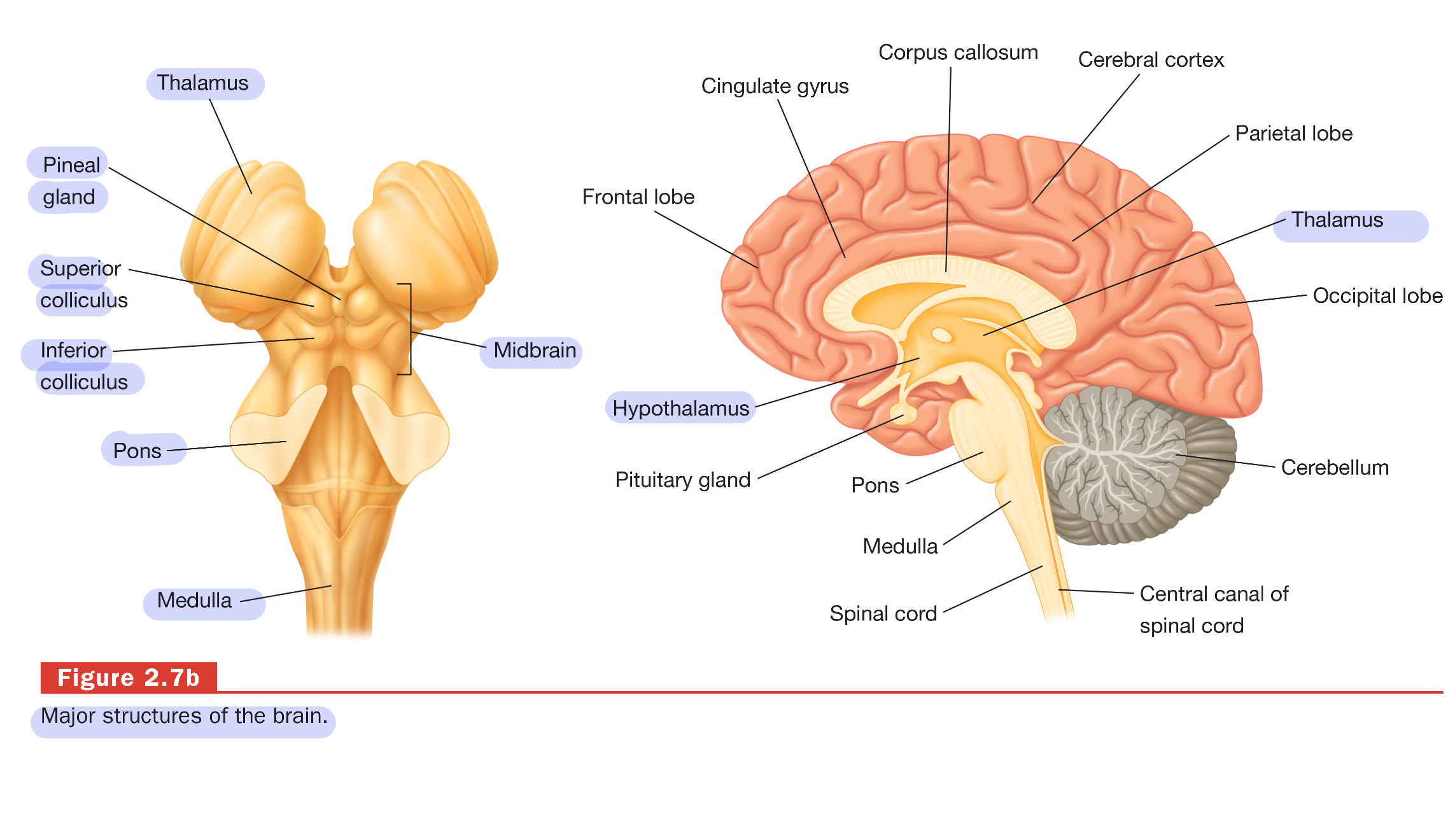
What is the role of the amygdala in emotional processing?
It is involved in processing emotions, particularly fear and pleasure, and plays a role in emotional memory.
What does the hippocampus do?
It is essential for forming new memories and is involved in spatial navigation and contextual processing.
What is the function of the hypothalamus?
It regulates autonomic functions and emotional responses, controlling hunger, thirst, and circadian rhythms.
What is the role of the thalamus in the brain?
It acts as a relay station for sensory information, directing it to appropriate brain regions for processing.
What does the cingulate gyrus regulate?
It is involved in processing emotions and behavior regulation, as well as regulating autonomic motor function.
What is the role of the limbic system in the brain?
The limbic system links emotions to sensory experiences and influences both conscious and unconscious processes.
What are the primary functions of the basal ganglia?
Coordinate and control voluntary movements, regulate muscle tone, and are involved in motor learning and habits.
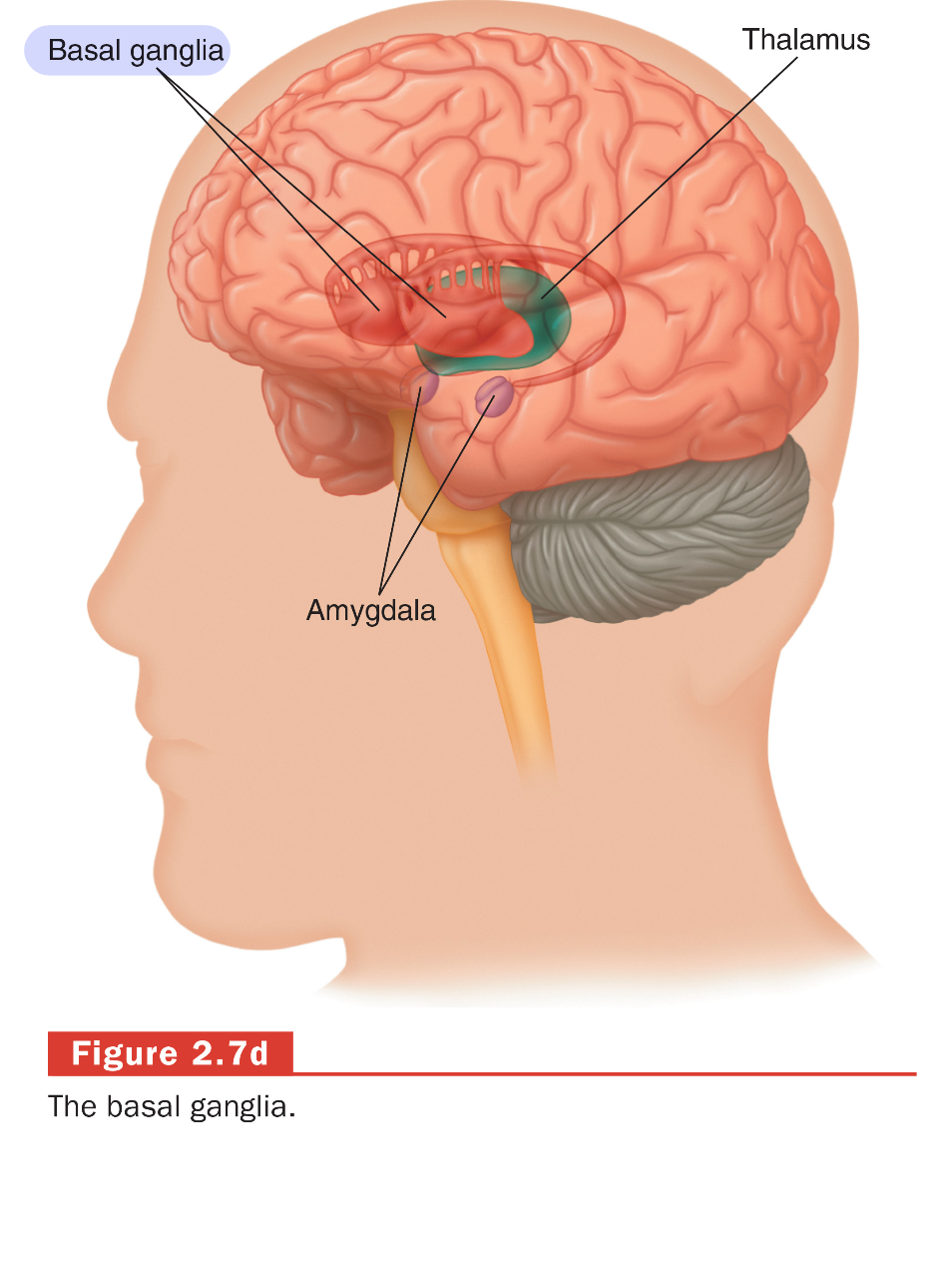
What movement disorders are associated with dysfunction of the basal ganglia?
Dysfunction is associated with Parkinson's disease and Huntington's disease.
What functions are associated with the frontal lobe?
The frontal lobe is responsible for voluntary movement, decision-making, problem-solving, planning, and personality traits.
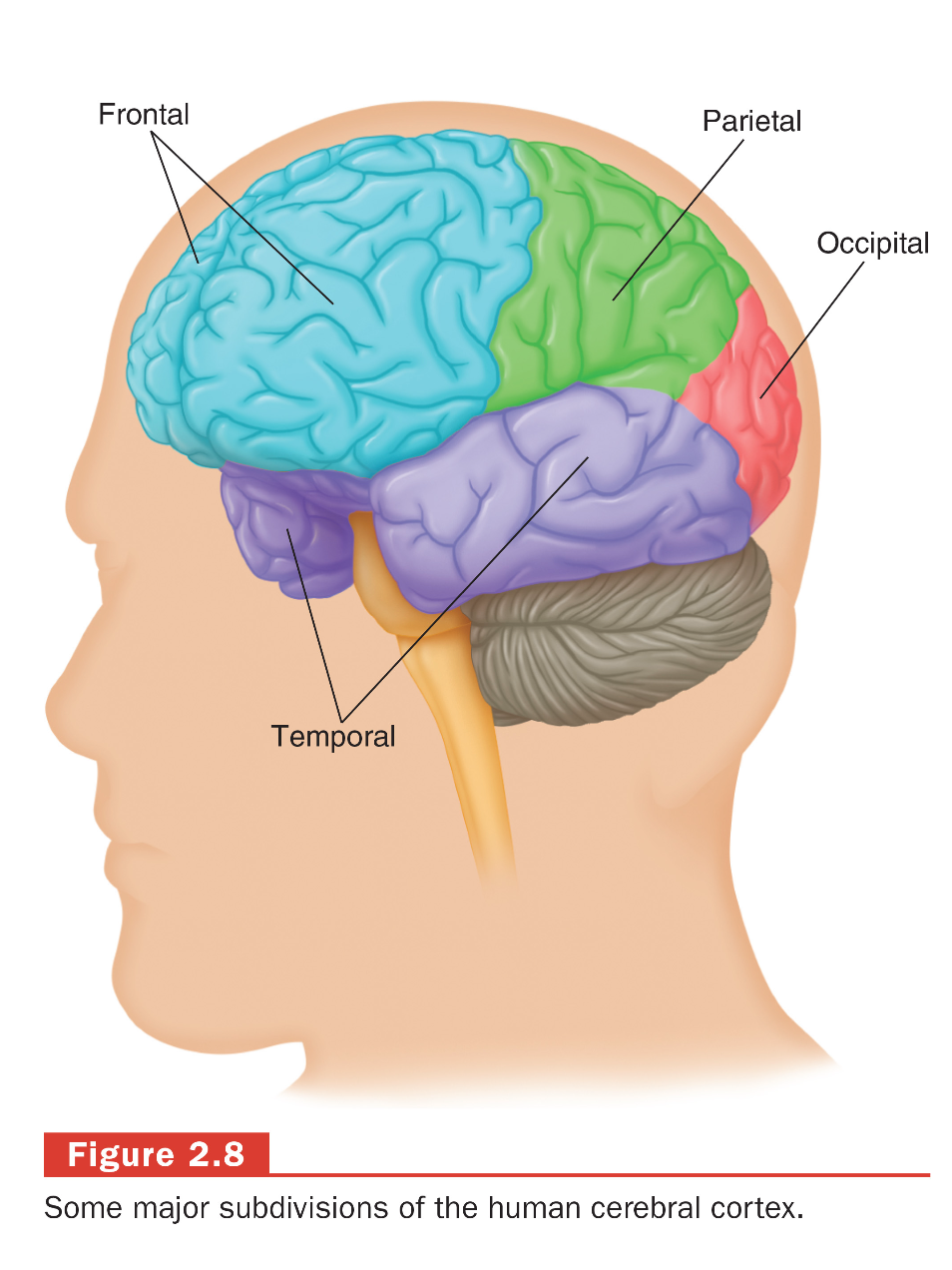
What sensory information does the parietal lobe process?
The parietal lobe processes sensory information such as touch, temperature, pain, and spatial awareness.
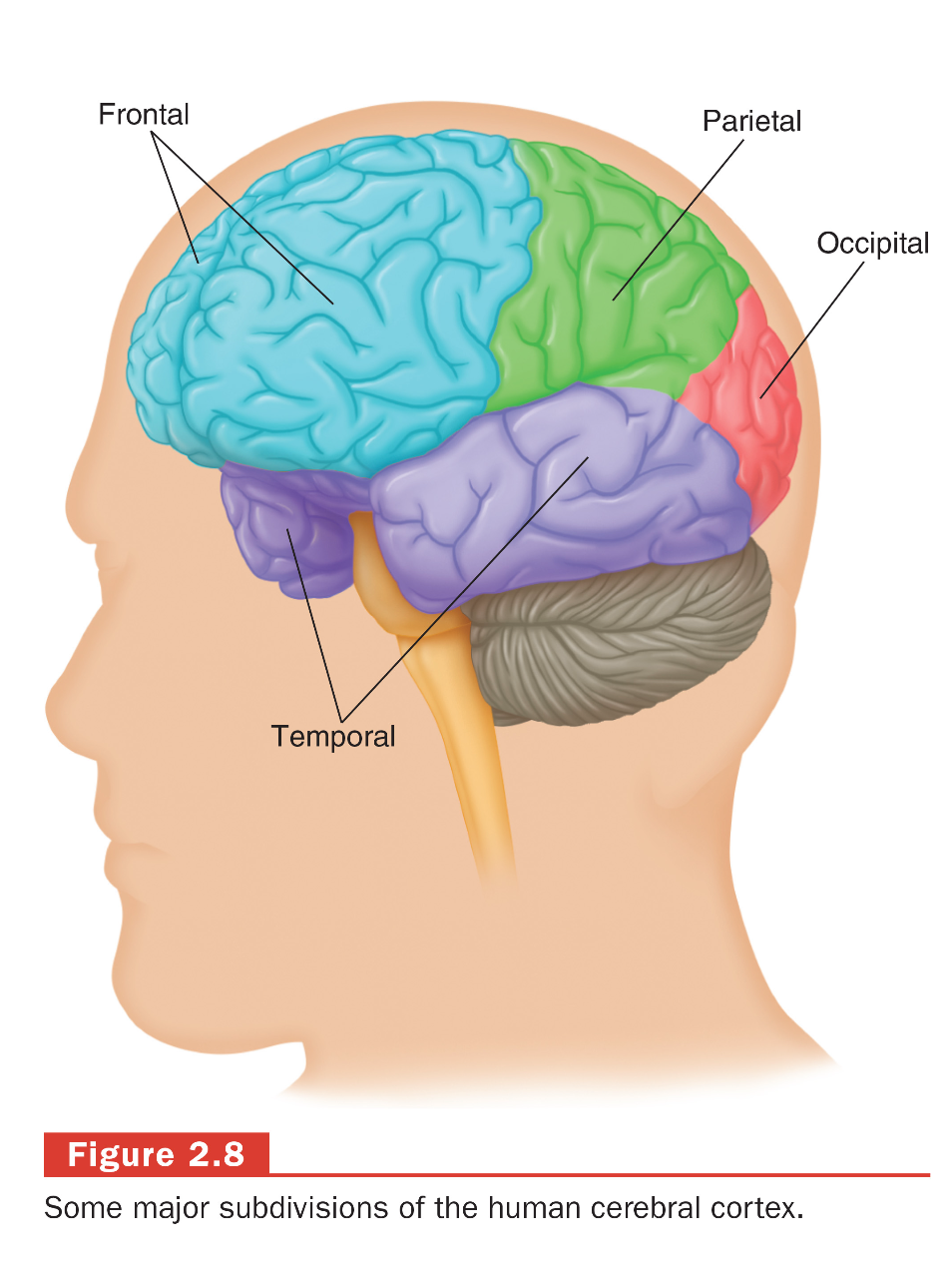
What is the main function of the temporal lobe?
The temporal lobe processes auditory information and is crucial for hearing, language comprehension, and memory.
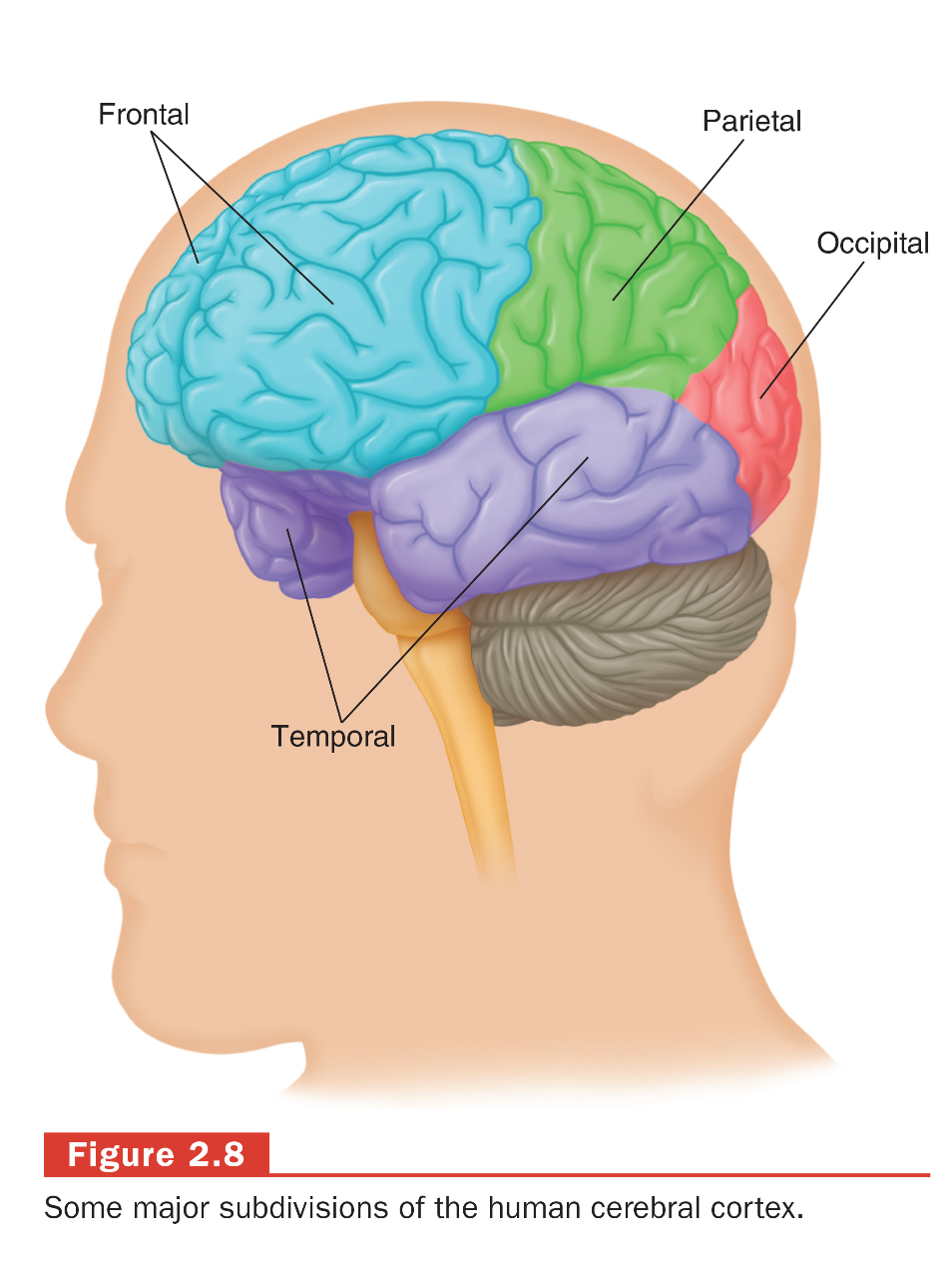
What is the role of the occipital lobe?
The occipital lobe is responsible for visual processing and interpreting visual stimuli.
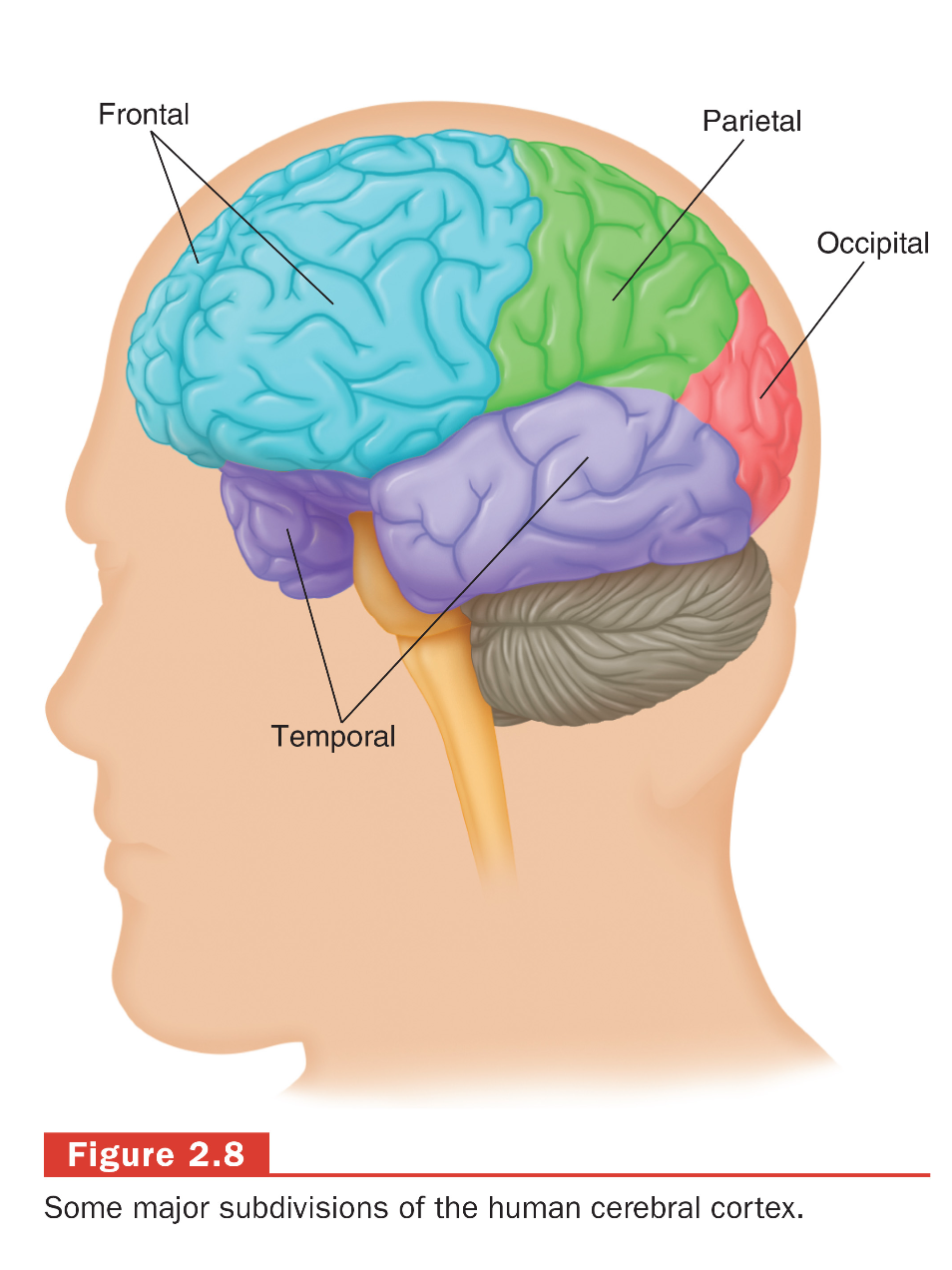
Serotonergic pathways in the brain

What is the function of the locus coeruleus in norepinephrine pathways?
Locus coeruleus to the cortex: projects to the entire cerebral cortex, modulating attention, arousal, and cognitive functions.
“ “ to the limbic system: sends fibers to amygdala, hippocampus and hypothalamus, influencing emotion, stress response and memory.
“ “ to the thalamus: modulates sensory signal processing, arousal and vigilance.
“ “ to the cerebellum: affects motor coordination.
“ “ to the spinal cord: involved in modulating pain and autonomic functions.
What is the function of the dopamine pathways in the brain?
• Mesolimbocortical Pathway: Originates from the ventral tegmental area (VTA) and projects to the nucleus accumbens, limbic areas, and prefrontal cortex. This pathway is involved in reward, motivation, and addiction.
• Mesostriatal System: Projects from the substantia nigra to the dorsal striatum. Involved in movement control and is notably affected in Parkinson's disease.
• Tuberoinfundibular Pathway: Projects from the hypothalamus to the pituitary gland, regulating prolactin secretion.
What is a risk factor in mental health?
A risk factor is anything that increases the likelihood of developing a health or mental health condition.
True or False: Correlation does not establish cause.
True. Just because two variables are associated does not mean that one of them causes the other.
What distinguishes a variable risk factor from a fixed marker?
A variable risk factor can change, while a fixed marker cannot be changed and may be linked to demographic factors like gender.
What are proximal risk factors?
Proximal risk factors occur shortly before the onset of symptoms, such as a significant disappointment.
What are distal risk factors?
Distal risk factors occur early in life and may not show effects for many years, such as childhood abuse.
What is a necessary cause in mental health disorders?
A characteristic that must exist for a disorder to occur, but doesn’t guarantee the outcome (e.g. trauma experience).
What is a sufficient cause in the context of mental health?
A sufficient cause guarantees the occurrence of a disorder; for example, hopelessness may be a sufficient cause for depression.
What is a contributory cause?
A contributory cause increases the probability of a disorder developing but is neither necessary nor sufficient.
What is a reinforcing contributory cause?
A reinforcing contributory cause maintains maladaptive behavior, such as attention received from being ill that discourages recovery.
What do biopsychosocial models address?
Frameworks that guide research and practice on mental health conditions, integrating biological, psychological, and social factors.
What is the goal of primary prevention in mental health?
The goal is to promote overall well-being and reduce risk factors to prevent mental health problems from developing.
What does secondary prevention in mental health aim to achieve?
Secondary prevention aims to identify and intervene early in the course of a mental health problem to prevent worsening.
(e.g. screening programs for depression in college students)
What is the focus of tertiary prevention in mental health?
Focuses on providing treatment and rehabilitation services for existing mental health conditions. (e.g. psychotherapy CBT)
What are some examples of primary prevention strategies?
Examples include mental health education programs, stress management workshops, and community awareness campaigns.
What are some examples of tertiary prevention strategies?
Examples include psychotherapy, medication management, and support groups for chronic mental health conditions.
What is the importance of accessibility in mental health treatment?
Treatments need to be accessible, scalable, and sustainable to effectively address mental health issues.